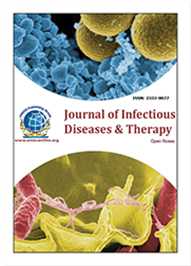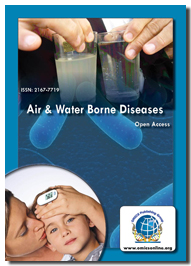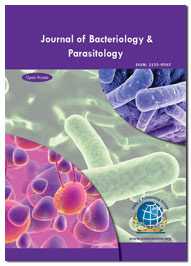Theme: Novel Technologies and Innovations for Prevention and Treatment of Infectious Diseases
Infection Control 2016
Track 01: Treatment for Infections
Treatment of viral infections such as HIV involves patient care and moral support including antiretroviral therapy. Bacterial infections can be treated by administering antibiotics to the patients. Yeast infections can be primarily treated by sterilisation methods. Parasitic infections can be treated by antiparasitic drugs. Diseases such as cancer can be treated by chemotherapy. Recent techniques have proved that there is no disease that cannot be treated.
Related Conferences
3rd Annual Congress on Infectious Diseases 2017, Aug 21-23, USA, 2nd Annual Conference on Rare Diseases and Orphan Drugs, Oct 30-Nov 01, 2017 USA, 3rd International Conference on Influenza and Zoonotic Diseases, Aug 21-22, 2017 UK, 4th International Conference on Chronic Obstructive Pulmonary Disease (COPD), May 29-31, 2017 Japan, 3rd International Conference on Flu, Oct 30-Nov 01, 2017 USA, Keystone Symposia: New developments in our basic understanding of tuberculosis, Jan 14-18, 2017 Canada, 35th UC Davis Annual infectious diseases conference, Feb 03-04, 2017 USA, 24th Conference on retroviruses and opportunistic infections, Feb 13-16, 2017 USA, Keystone Symposia Malaria: From innovation to eradication, Feb 19-23, 2017 Uganda, Australasian society for infectious diseases annual scientific meeting, Mar 29-Apr 01, 2017 Australia.
Track 02: Infection Prevention, Control Measures and Cure
Infection prevention and control is helpful to prevent the transmission of infectious diseases. Aseptic technique is normally applied to prevent the infections caused by different means. Sterilization is another process of killing microorganisms by the application of heat. Disinfection is the process of killing harmful microorganisms. Some infectious diseases can be prevented by avoiding direct contact with the contagious person. Infections can also be controlled and prevented by creating public awareness on various infectious diseases and their outbreaks. Infections can be cured by various antimicrobials.
Related Conferences
3rd Annual Congress on Infectious Diseases 2017, Aug 21-23, USA, 2nd Annual Conference on Rare Diseases and Orphan Drugs, Oct 30-Nov 01, 2017 USA, 3rd International Conference on Influenza and Zoonotic Diseases, Aug 21-22, 2017 UK, 4th International Conference on Chronic Obstructive Pulmonary Disease (COPD), May 29-31, 2017 Japan, 3rd International Conference on Flu, Oct 30-Nov 01, 2017 USA, Keystone Symposia: New developments in our basic understanding of tuberculosis, Jan 14-18, 2017 Canada, 35th UC Davis Annual infectious diseases conference, Feb 03-04, 2017 USA, 24th Conference on retroviruses and opportunistic infections, Feb 13-16, 2017 USA, Keystone Symposia Malaria: From innovation to eradication, Feb 19-23, 2017 Uganda, Australasian society for infectious diseases annual scientific meeting, Mar 29-Apr 01, 2017 Australia.
Track 03: Hand Hygiene/ Hand Washing and Cleanliness
Hand hygiene/ hand washing is a method of removing or destroying microorganisms on hands. It is well documented that the most important measure for preventing the spread of pathogens is effective hand washing. Cleanliness is both the abstract state of being clean and free from dirt, and the process of achieving and maintaining that state.
Related Conferences
3rd Annual Congress on Infectious Diseases 2017, Aug 21-23, USA, 2nd Annual Conference on Rare Diseases and Orphan Drugs, Oct 30-Nov 01, 2017 USA, 3rd International Conference on Influenza and Zoonotic Diseases, Aug 21-22, 2017 UK, 4th International Conference on Chronic Obstructive Pulmonary Disease (COPD), May 29-31, 2017 Japan, 3rd International Conference on Flu, Oct 30-Nov 01, 2017 USA, Keystone Symposia: New developments in our basic understanding of tuberculosis, Jan 14-18, 2017 Canada, 35th UC Davis Annual infectious diseases conference, Feb 03-04, 2017 USA, 24th Conference on retroviruses and opportunistic infections, Feb 13-16, 2017 USA, Keystone Symposia Malaria: From innovation to eradication, Feb 19-23, 2017 Uganda, Australasian society for infectious diseases annual scientific meeting, Mar 29-Apr 01, 2017 Australia.
Track 04: Vaccines and Vaccination
Vaccines are the products that are able to produce immunity from a disease and can be administered through needle injections, by mouth and by aerosol. Vaccination is the injection of a killed or weakened organism that produces immunity in the body against that organism.
Related Conferences
3rd Annual Congress on Infectious Diseases 2017, Aug 21-23, USA, 2nd Annual Conference on Rare Diseases and Orphan Drugs, Oct 30-Nov 01, 2017 USA, 3rd International Conference on Influenza and Zoonotic Diseases, Aug 21-22, 2017 UK, 4th International Conference on Chronic Obstructive Pulmonary Disease (COPD), May 29-31, 2017 Japan, 3rd International Conference on Flu, Oct 30-Nov 01, 2017 USA, Keystone Symposia: New developments in our basic understanding of tuberculosis, Jan 14-18, 2017 Canada, 35th UC Davis Annual infectious diseases conference, Feb 03-04, 2017 USA, 24th Conference on retroviruses and opportunistic infections, Feb 13-16, 2017 USA, Keystone Symposia Malaria: From innovation to eradication, Feb 19-23, 2017 Uganda, Australasian society for infectious diseases annual scientific meeting, Mar 29-Apr 01, 2017 Australia.
Track 05: Antimicrobials/ Antibiotics/ Antibacterials
Antimicrobials/ antibiotics/ antibacterials are the drugs used in the treatment and prevention of bacterial infections. They may either kill or inhibit the growth of bacteria. Few antibiotics possess antiprotozoal activity. Antibiotics are not effective against viruses such as the common cold or influenza and their inappropriate use allows the emergence of resistant organisms.
Related Conferences
3rd Annual Congress on Infectious Diseases 2017, Aug 21-23, USA, 2nd Annual Conference on Rare Diseases and Orphan Drugs, Oct 30-Nov 01, 2017 USA, 3rd International Conference on Influenza and Zoonotic Diseases, Aug 21-22, 2017 UK, 4th International Conference on Chronic Obstructive Pulmonary Disease (COPD), May 29-31, 2017 Japan, 3rd International Conference on Flu, Oct 30-Nov 01, 2017 USA, Keystone Symposia: New developments in our basic understanding of tuberculosis, Jan 14-18, 2017 Canada, 35th UC Davis Annual infectious diseases conference, Feb 03-04, 2017 USA, 24th Conference on retroviruses and opportunistic infections, Feb 13-16, 2017 USA, Keystone Symposia Malaria: From innovation to eradication, Feb 19-23, 2017 Uganda, Australasian society for infectious diseases annual scientific meeting, Mar 29-Apr 01, 2017 Australia.
Track 06: Chemotherapy Role in Infections Prevention and Control
Chemotherapy means the treatment of infections or any other diseases by the use of chemical substances.
Related Conferences
3rd Annual Congress on Infectious Diseases 2017, Aug 21-23, USA, 2nd Annual Conference on Rare Diseases and Orphan Drugs, Oct 30-Nov 01, 2017 USA, 3rd International Conference on Influenza and Zoonotic Diseases, Aug 21-22, 2017 UK, 4th International Conference on Chronic Obstructive Pulmonary Disease (COPD), May 29-31, 2017 Japan, 3rd International Conference on Flu, Oct 30-Nov 01, 2017 USA, Keystone Symposia: New developments in our basic understanding of tuberculosis, Jan 14-18, 2017 Canada, 35th UC Davis Annual infectious diseases conference, Feb 03-04, 2017 USA, 24th Conference on retroviruses and opportunistic infections, Feb 13-16, 2017 USA, Keystone Symposia Malaria: From innovation to eradication, Feb 19-23, 2017 Uganda, Australasian society for infectious diseases annual scientific meeting, Mar 29-Apr 01, 2017 Australia.
Track 07: Neonatal Intensive Care Unit/ New Born Intensive Care/ Intensive Care Nursery
A neonatal intensive care unit/ new born intensive care/ intensive care nursery is an intensive care unit specializing in the care of ill or premature new born infants.
Related Conferences
3rd Annual Congress on Infectious Diseases 2017, Aug 21-23, USA, 2nd Annual Conference on Rare Diseases and Orphan Drugs, Oct 30-Nov 01, 2017 USA, 3rd International Conference on Influenza and Zoonotic Diseases, Aug 21-22, 2017 UK, 4th International Conference on Chronic Obstructive Pulmonary Disease (COPD), May 29-31, 2017 Japan, 3rd International Conference on Flu, Oct 30-Nov 01, 2017 USA, Keystone Symposia: New developments in our basic understanding of tuberculosis, Jan 14-18, 2017 Canada, 35th UC Davis Annual infectious diseases conference, Feb 03-04, 2017 USA, 24th Conference on retroviruses and opportunistic infections, Feb 13-16, 2017 USA, Keystone Symposia Malaria: From innovation to eradication, Feb 19-23, 2017 Uganda, Australasian society for infectious diseases annual scientific meeting, Mar 29-Apr 01, 2017 Australia.
Track 08: Antimicrobial/ Antibiotic/ Antibacterial Resistance
Antimicrobial/ antibiotic/ antibacterial resistance is the ability of microorganisms to resist the effects of drugs that means diseases causing germs do not get killed and their growth is not stopped. Antibiotic resistant infections are of greater risk which cannot be avoided completely. Infections with resistant organisms are difficult to treat requiring costly and sometimes toxic alternatives.
Related Conferences
3rd Annual Congress on Infectious Diseases 2017, Aug 21-23, USA, 2nd Annual Conference on Rare Diseases and Orphan Drugs, Oct 30-Nov 01, 2017 USA, 3rd International Conference on Influenza and Zoonotic Diseases, Aug 21-22, 2017 UK, 4th International Conference on Chronic Obstructive Pulmonary Disease (COPD), May 29-31, 2017 Japan, 3rd International Conference on Flu, Oct 30-Nov 01, 2017 USA, Keystone Symposia: New developments in our basic understanding of tuberculosis, Jan 14-18, 2017 Canada, 35th UC Davis Annual infectious diseases conference, Feb 03-04, 2017 USA, 24th Conference on retroviruses and opportunistic infections, Feb 13-16, 2017 USA, Keystone Symposia Malaria: From innovation to eradication, Feb 19-23, 2017 Uganda, Australasian society for infectious diseases annual scientific meeting, Mar 29-Apr 01, 2017 Australia.
Track 09: Antimicrobial/ Antibiotic/ Antibacterial Stewardship
Antimicrobial/ antibiotic/ antibacterial stewardship promotes the appropriate use of antimicrobials which improves patient outcomes reduces microbial resistance and decreases the spread of infections caused by multidrug resistant organisms.
Related Conferences
3rd Annual Congress on Infectious Diseases 2017, Aug 21-23, USA, 2nd Annual Conference on Rare Diseases and Orphan Drugs, Oct 30-Nov 01, 2017 USA, 3rd International Conference on Influenza and Zoonotic Diseases, Aug 21-22, 2017 UK, 4th International Conference on Chronic Obstructive Pulmonary Disease (COPD), May 29-31, 2017 Japan, 3rd International Conference on Flu, Oct 30-Nov 01, 2017 USA, Keystone Symposia: New developments in our basic understanding of tuberculosis, Jan 14-18, 2017 Canada, 35th UC Davis Annual infectious diseases conference, Feb 03-04, 2017 USA, 24th Conference on retroviruses and opportunistic infections, Feb 13-16, 2017 USA, Keystone Symposia Malaria: From innovation to eradication, Feb 19-23, 2017 Uganda, Australasian society for infectious diseases annual scientific meeting, Mar 29-Apr 01, 2017 Australia.
Nosocomial infections/ hospital acquired infections/ health care associated infections are the infections that are contracted from the environment or staff of a healthcare facility and they spread in the hospital environment, nursing home environment, rehabilitation facility and clinic or other clinical settings.
Related Conferences
3rd Annual Congress on Infectious Diseases 2017, Aug 21-23, USA, 2nd Annual Conference on Rare Diseases and Orphan Drugs, Oct 30-Nov 01, 2017 USA, 3rd International Conference on Influenza and Zoonotic Diseases, Aug 21-22, 2017 UK, 4th International Conference on Chronic Obstructive Pulmonary Disease (COPD), May 29-31, 2017 Japan, 3rd International Conference on Flu, Oct 30-Nov 01, 2017 USA, Keystone Symposia: New developments in our basic understanding of tuberculosis, Jan 14-18, 2017 Canada, 35th UC Davis Annual infectious diseases conference, Feb 03-04, 2017 USA, 24th Conference on retroviruses and opportunistic infections, Feb 13-16, 2017 USA, Keystone Symposia Malaria: From innovation to eradication, Feb 19-23, 2017 Uganda, Australasian society for infectious diseases annual scientific meeting, Mar 29-Apr 01, 2017 Australia.
Track 11: Pulmonary Infections and Respiratory Tract Infections Prevention and Control
Pulmonary infections are mostly observed in lungs which in turn causes acute bronchitis or pneumonia which are often caused by viruses but also can be caused by bacteria or fungal organisms. Respiratory tract infections are the infections which are observed in the respiratory tract ad they are further classified as upper respiratory tract infections and lower respiratory tract infections.
Related Conferences
3rd Annual Congress on Infectious Diseases 2017, Aug 21-23, USA, 2nd Annual Conference on Rare Diseases and Orphan Drugs, Oct 30-Nov 01, 2017 USA, 3rd International Conference on Influenza and Zoonotic Diseases, Aug 21-22, 2017 UK, 4th International Conference on Chronic Obstructive Pulmonary Disease (COPD), May 29-31, 2017 Japan, 3rd International Conference on Flu, Oct 30-Nov 01, 2017 USA, Keystone Symposia: New developments in our basic understanding of tuberculosis, Jan 14-18, 2017 Canada, 35th UC Davis Annual infectious diseases conference, Feb 03-04, 2017 USA, 24th Conference on retroviruses and opportunistic infections, Feb 13-16, 2017 USA, Keystone Symposia Malaria: From innovation to eradication, Feb 19-23, 2017 Uganda, Australasian society for infectious diseases annual scientific meeting, Mar 29-Apr 01, 2017 Australia.
Track 12: Pediatric Infections/ Childhood Infections Prevention and Control
Pediatric infections/ childhood infections are the infections which are caused in children of different age groups. Pediatric infections specialist’s takes care of the infections occurring in children and the treatment methods vary for children from adults.
Related Conferences
3rd Annual Congress on Infectious Diseases 2017, Aug 21-23, USA, 2nd Annual Conference on Rare Diseases and Orphan Drugs, Oct 30-Nov 01, 2017 USA, 3rd International Conference on Influenza and Zoonotic Diseases, Aug 21-22, 2017 UK, 4th International Conference on Chronic Obstructive Pulmonary Disease (COPD), May 29-31, 2017 Japan, 3rd International Conference on Flu, Oct 30-Nov 01, 2017 USA, Keystone Symposia: New developments in our basic understanding of tuberculosis, Jan 14-18, 2017 Canada, 35th UC Davis Annual infectious diseases conference, Feb 03-04, 2017 USA, 24th Conference on retroviruses and opportunistic infections, Feb 13-16, 2017 USA, Keystone Symposia Malaria: From innovation to eradication, Feb 19-23, 2017 Uganda, Australasian society for infectious diseases annual scientific meeting, Mar 29-Apr 01, 2017 Australia.
Track 13: Tuberculosis, Hepatitis and Malaria Prevention and Control
Tuberculosis is a bacterial infection caused by a bacterium called mycobacterium tuberculosis which spread through the lymph nodes and blood stream to any organ in your body. It is most commonly found in the lungs which attack the lungs and it can also attack any part of the body such as the kidney, spine and brain. Hepatitis infection is caused by the inflammation of the liver and characterized by the presence of inflammatory cells in the tissue of the organ. Hepatitis may occur with limited or no symptoms but often leads to jaundice, poor appetite and malaise. Hepatitis is acute when it lasts less than six months and chronic when it persists longer. Malaria is a mosquito borne infection affecting humans and other animals caused by parasitic protozoans (a group of single celled microorganisms) belonging to the plasmodium type. Malaria symptoms typically include fever, fatigue, vomiting and headaches which can be observed in 10-15 after being bitten by mosquito. In severe cases it can cause yellow skin, seizures, comaor and even death.
Related Conferences
3rd Annual Congress on Infectious Diseases 2017, Aug 21-23, USA, 2nd Annual Conference on Rare Diseases and Orphan Drugs, Oct 30-Nov 01, 2017 USA, 3rd International Conference on Influenza and Zoonotic Diseases, Aug 21-22, 2017 UK, 4th International Conference on Chronic Obstructive Pulmonary Disease (COPD), May 29-31, 2017 Japan, 3rd International Conference on Flu, Oct 30-Nov 01, 2017 USA, Keystone Symposia: New developments in our basic understanding of tuberculosis, Jan 14-18, 2017 Canada, 35th UC Davis Annual infectious diseases conference, Feb 03-04, 2017 USA, 24th Conference on retroviruses and opportunistic infections, Feb 13-16, 2017 USA, Keystone Symposia Malaria: From innovation to eradication, Feb 19-23, 2017 Uganda, Australasian society for infectious diseases annual scientific meeting, Mar 29-Apr 01, 2017 Australia.
Track 14: Ebola and Zika Viral Infections Prevention and Control
Ebola viral infection is caused by virus transmitted through body fluids and through air. It occurs rarely but it is very deadly which results in death and outbreak. Ebola virus disease symptoms are very severe which appears in 2-3 days. Ebola primary symptoms include fever, sore throat, muscular pain and headaches then followed by vomiting, diarrhea, rash, decreased function of the liver and kidneys then loss of blood internally and externally finally leading to low blood pressure and fluid loss resulting in death. Zika viral infection is caused by a virus transmitted primarily by aedes mosquitoes. People with zika virus disease can have symptoms including mild fever, skin rash, conjunctivitis, muscle and joint pain and malaise or headache.
Related Conferences
3rd Annual Congress on Infectious Diseases 2017, Aug 21-23, USA, 2nd Annual Conference on Rare Diseases and Orphan Drugs, Oct 30-Nov 01, 2017 USA, 3rd International Conference on Influenza and Zoonotic Diseases, Aug 21-22, 2017 UK, 4th International Conference on Chronic Obstructive Pulmonary Disease (COPD), May 29-31, 2017 Japan, 3rd International Conference on Flu, Oct 30-Nov 01, 2017 USA, Keystone Symposia: New developments in our basic understanding of tuberculosis, Jan 14-18, 2017 Canada, 35th UC Davis Annual infectious diseases conference, Feb 03-04, 2017 USA, 24th Conference on retroviruses and opportunistic infections, Feb 13-16, 2017 USA, Keystone Symposia Malaria: From innovation to eradication, Feb 19-23, 2017 Uganda, Australasian society for infectious diseases annual scientific meeting, Mar 29-Apr 01, 2017 Australia.
Track 15: Dengue and Chikungunya Prevention and Control
Dengue is a debilitating viral infection of the tropics, transmitted by mosquitoes which inturn causes sudden fever and acute pains in the joints. Chikungunya is a febrile infection that resembles dengue which occurs especially in parts of Africa, India and South Eastern Asia caused by a toga virus of the genus aphavirus (species chikungunya virus) and transmitted by mosquitoes especially of the genus aedes.
Related Conferences
3rd Annual Congress on Infectious Diseases 2017, Aug 21-23, USA, 2nd Annual Conference on Rare Diseases and Orphan Drugs, Oct 30-Nov 01, 2017 USA, 3rd International Conference on Influenza and Zoonotic Diseases, Aug 21-22, 2017 UK, 4th International Conference on Chronic Obstructive Pulmonary Disease (COPD), May 29-31, 2017 Japan, 3rd International Conference on Flu, Oct 30-Nov 01, 2017 USA, Keystone Symposia: New developments in our basic understanding of tuberculosis, Jan 14-18, 2017 Canada, 35th UC Davis Annual infectious diseases conference, Feb 03-04, 2017 USA, 24th Conference on retroviruses and opportunistic infections, Feb 13-16, 2017 USA, Keystone Symposia Malaria: From innovation to eradication, Feb 19-23, 2017 Uganda, Australasian society for infectious diseases annual scientific meeting, Mar 29-Apr 01, 2017 Australia.
Track 16: STDS, STIS and HIV/ AIDS Prevention and Control
Sexually transmitted diseases/ sexually transmitted infections are the infections which are transmitted through sexual contact with an infected individual and also transmitted during vaginal or other types of sexual intercourse including oral and anal sex. Human immunodeficiency virus infection and acquired immune deficiency syndrome (HIV/AIDS) is a spectrum of conditions caused by infection with the human immunodeficiency virus (HIV).
Related Conferences
3rd Annual Congress on Infectious Diseases 2017, Aug 21-23, USA, 2nd Annual Conference on Rare Diseases and Orphan Drugs, Oct 30-Nov 01, 2017 USA, 3rd International Conference on Influenza and Zoonotic Diseases, Aug 21-22, 2017 UK, 4th International Conference on Chronic Obstructive Pulmonary Disease (COPD), May 29-31, 2017 Japan, 3rd International Conference on Flu, Oct 30-Nov 01, 2017 USA, Keystone Symposia: New developments in our basic understanding of tuberculosis, Jan 14-18, 2017 Canada, 35th UC Davis Annual infectious diseases conference, Feb 03-04, 2017 USA, 24th Conference on retroviruses and opportunistic infections, Feb 13-16, 2017 USA, Keystone Symposia Malaria: From innovation to eradication, Feb 19-23, 2017 Uganda, Australasian society for infectious diseases annual scientific meeting, Mar 29-Apr 01, 2017 Australia.
Track 17: Infections
The infections caused by germs and which may infect any part of the body are called infectious diseases. They can be spread by any means where there is a germ. They are caused by pathogenic microorganisms such as bacteria, virus, parasites and fungi. Germs can be spread by direct or indirect contact. Vaccination, maintenance of proper hygiene and medicines help in the prevention of infection.
Related Conferences
3rd Annual Congress on Infectious Diseases 2017, Aug 21-23, USA, 2nd Annual Conference on Rare Diseases and Orphan Drugs, Oct 30-Nov 01, 2017 USA, 3rd International Conference on Influenza and Zoonotic Diseases, Aug 21-22, 2017 UK, 4th International Conference on Chronic Obstructive Pulmonary Disease (COPD), May 29-31, 2017 Japan, 3rd International Conference on Flu, Oct 30-Nov 01, 2017 USA, Keystone Symposia: New developments in our basic understanding of tuberculosis, Jan 14-18, 2017 Canada, 35th UC Davis Annual infectious diseases conference, Feb 03-04, 2017 USA, 24th Conference on retroviruses and opportunistic infections, Feb 13-16, 2017 USA, Keystone Symposia Malaria: From innovation to eradication, Feb 19-23, 2017 Uganda, Australasian society for infectious diseases annual scientific meeting, Mar 29-Apr 01, 2017 Australia.
Track 18: Causes and Symptoms of Infections
Infections can be caused by bacteria, virus, fungi and parasites through direct contact, indirect contact, insect bites and food contamination. Each infectious disease has its own specific signs and symptoms. General signs and symptoms common to a number of infectious diseases include fever, diarrhoea, fatigue and muscle aches.
Related Conferences
3rd Annual Congress on Infectious Diseases 2017, Aug 21-23, USA, 2nd Annual Conference on Rare Diseases and Orphan Drugs, Oct 30-Nov 01, 2017 USA, 3rd International Conference on Influenza and Zoonotic Diseases, Aug 21-22, 2017 UK, 4th International Conference on Chronic Obstructive Pulmonary Disease (COPD), May 29-31, 2017 Japan, 3rd International Conference on Flu, Oct 30-Nov 01, 2017 USA, Keystone Symposia: New developments in our basic understanding of tuberculosis, Jan 14-18, 2017 Canada, 35th UC Davis Annual infectious diseases conference, Feb 03-04, 2017 USA, 24th Conference on retroviruses and opportunistic infections, Feb 13-16, 2017 USA, Keystone Symposia Malaria: From innovation to eradication, Feb 19-23, 2017 Uganda, Australasian society for infectious diseases annual scientific meeting, Mar 29-Apr 01, 2017 Australia.
Track 19: Global Trends in Emerging Infections
An infection whose occurrence has increased in the past years or threatens to increase is termed as emerging. These diseases include new infections, previously unrecognized infections and old infections reappearing due to antimicrobial resistance, public health issues and unhygienic conditions.
Related Conferences
3rd Annual Congress on Infectious Diseases 2017, Aug 21-23, USA, 2nd Annual Conference on Rare Diseases and Orphan Drugs, Oct 30-Nov 01, 2017 USA, 3rd International Conference on Influenza and Zoonotic Diseases, Aug 21-22, 2017 UK, 4th International Conference on Chronic Obstructive Pulmonary Disease (COPD), May 29-31, 2017 Japan, 3rd International Conference on Flu, Oct 30-Nov 01, 2017 USA, Keystone Symposia: New developments in our basic understanding of tuberculosis, Jan 14-18, 2017 Canada, 35th UC Davis Annual infectious diseases conference, Feb 03-04, 2017 USA, 24th Conference on retroviruses and opportunistic infections, Feb 13-16, 2017 USA, Keystone Symposia Malaria: From innovation to eradication, Feb 19-23, 2017 Uganda, Australasian society for infectious diseases annual scientific meeting, Mar 29-Apr 01, 2017 Australia.
Track 20: Clinical Studies and Case Reports
Clinical studies helps in inventing new treatment methods which helps in providing effective treatment. Case reports on infectious diseases include research, biology, epidemiology and clinical aspects of all infection related diseases.
Related Conferences
3rd Annual Congress on Infectious Diseases 2017, Aug 21-23, USA, 2nd Annual Conference on Rare Diseases and Orphan Drugs, Oct 30-Nov 01, 2017 USA, 3rd International Conference on Influenza and Zoonotic Diseases, Aug 21-22, 2017 UK, 4th International Conference on Chronic Obstructive Pulmonary Disease (COPD), May 29-31, 2017 Japan, 3rd International Conference on Flu, Oct 30-Nov 01, 2017 USA, Keystone Symposia: New developments in our basic understanding of tuberculosis, Jan 14-18, 2017 Canada, 35th UC Davis Annual infectious diseases conference, Feb 03-04, 2017 USA, 24th Conference on retroviruses and opportunistic infections, Feb 13-16, 2017 USA, Keystone Symposia Malaria: From innovation to eradication, Feb 19-23, 2017 Uganda, Australasian society for infectious diseases annual scientific meeting, Mar 29-Apr 01, 2017 Australia.
Track 21: Microbial Pathogenesis and Virulence
Microbial pathogenesis is the study of the molecular mechanisms used by microorganisms to cause disease in humans and animals. By understanding how pathogens cause disease helps in the development of new therapeutic approaches. Virulence is the measure of the pathogenicity of an organism. The degree of virulence is related directly to the ability of the organism to cause infection despite host resistance mechanisms, it is affected by numerous variables such as the number of infecting bacteria, route of entry into the body, specific and nonspecific host defence mechanisms and virulence factors of the bacterium.
Related Conferences
3rd Annual Congress on Infectious Diseases 2017, Aug 21-23, USA, 2nd Annual Conference on Rare Diseases and Orphan Drugs, Oct 30-Nov 01, 2017 USA, 3rd International Conference on Influenza and Zoonotic Diseases, Aug 21-22, 2017 UK, 4th International Conference on Chronic Obstructive Pulmonary Disease (COPD), May 29-31, 2017 Japan, 3rd International Conference on Flu, Oct 30-Nov 01, 2017 USA, Keystone Symposia: New developments in our basic understanding of tuberculosis, Jan 14-18, 2017 Canada, 35th UC Davis Annual infectious diseases conference, Feb 03-04, 2017 USA, 24th Conference on retroviruses and opportunistic infections, Feb 13-16, 2017 USA, Keystone Symposia Malaria: From innovation to eradication, Feb 19-23, 2017 Uganda, Australasian society for infectious diseases annual scientific meeting, Mar 29-Apr 01, 2017 Australia.
Track 22: Immunology of Infections
Immunology of infections means the battle between pathogens and the host immune defences. Immunology is the branch of science concerned with the various aspects related to immune system, innate and acquired immunity. Immunology also deals with laboratory techniques involving the interaction of antigens with specific antibodies.
Related Conferences
3rd Annual Congress on Infectious Diseases 2017, Aug 21-23, USA, 2nd Annual Conference on Rare Diseases and Orphan Drugs, Oct 30-Nov 01, 2017 USA, 3rd International Conference on Influenza and Zoonotic Diseases, Aug 21-22, 2017 UK, 4th International Conference on Chronic Obstructive Pulmonary Disease (COPD), May 29-31, 2017 Japan, 3rd International Conference on Flu, Oct 30-Nov 01, 2017 USA, Keystone Symposia: New developments in our basic understanding of tuberculosis, Jan 14-18, 2017 Canada, 35th UC Davis Annual infectious diseases conference, Feb 03-04, 2017 USA, 24th Conference on retroviruses and opportunistic infections, Feb 13-16, 2017 USA, Keystone Symposia Malaria: From innovation to eradication, Feb 19-23, 2017 Uganda, Australasian society for infectious diseases annual scientific meeting, Mar 29-Apr 01, 2017 Australia.
Track 23: Mechanism of Resistance
Mechanism of resistance towards antimicrobials by microorganisms includes the following mechanisms of enzymatic destruction, enzymatic modification, altered target and decreased uptake. Mechanism of resistance is due to the inactivation or modification of antibiotics, an alteration in the target site of the antibiotic that reduces its binding capacity, the modification of metabolic pathways to circumvent the antibiotic effect and the reduced intracellular antibiotic accumulation by decreasing permeability and/ or increasing active efflux of the antibiotic.
Related Conferences
3rd Annual Congress on Infectious Diseases 2017, Aug 21-23, USA, 2nd Annual Conference on Rare Diseases and Orphan Drugs, Oct 30-Nov 01, 2017 USA, 3rd International Conference on Influenza and Zoonotic Diseases, Aug 21-22, 2017 UK, 4th International Conference on Chronic Obstructive Pulmonary Disease (COPD), May 29-31, 2017 Japan, 3rd International Conference on Flu, Oct 30-Nov 01, 2017 USA, Keystone Symposia: New developments in our basic understanding of tuberculosis, Jan 14-18, 2017 Canada, 35th UC Davis Annual infectious diseases conference, Feb 03-04, 2017 USA, 24th Conference on retroviruses and opportunistic infections, Feb 13-16, 2017 USA, Keystone Symposia Malaria: From innovation to eradication, Feb 19-23, 2017 Uganda, Australasian society for infectious diseases annual scientific meeting, Mar 29-Apr 01, 2017 Australia.
Track 24: Epidemiology of Emerging and Re-Emerging Infections
Epidemiology studies the patterns, causes and effects of health and disease conditions. It is the cornerstone of public health and informs policy decisions and evidence based practice by identifying risk factors for disease and targets for preventive healthcare. Epidemiologists help with study design, data collection, statistical analysis of data, interpretation and dissemination. Epidemiology helped to develop methodology used in clinical research, public health studies and to a lesser extent basic research in the biological sciences.
Related Conferences
3rd Annual Congress on Infectious Diseases 2017, Aug 21-23, USA, 2nd Annual Conference on Rare Diseases and Orphan Drugs, Oct 30-Nov 01, 2017 USA, 3rd International Conference on Influenza and Zoonotic Diseases, Aug 21-22, 2017 UK, 4th International Conference on Chronic Obstructive Pulmonary Disease (COPD), May 29-31, 2017 Japan, 3rd International Conference on Flu, Oct 30-Nov 01, 2017 USA, Keystone Symposia: New developments in our basic understanding of tuberculosis, Jan 14-18, 2017 Canada, 35th UC Davis Annual infectious diseases conference, Feb 03-04, 2017 USA, 24th Conference on retroviruses and opportunistic infections, Feb 13-16, 2017 USA, Keystone Symposia Malaria: From innovation to eradication, Feb 19-23, 2017 Uganda, Australasian society for infectious diseases annual scientific meeting, Mar 29-Apr 01, 2017 Australia.
Track 25: Diagnosis of Infections
Medical diagnosis is the process of determining which disease or condition explains a person's symptoms and signs. Laboratory tests may identify organisms directly (e.g., visually, using a microscope growing the organism in culture) or indirectly (e.g., identifying antibodies to the organism). General types of tests include microscopy, culture and immunologic tests (agglutination tests such as latex agglutination, enzyme immunoassays, western blot, precipitation tests and complement fixation tests) and nucleic acid/ non nucleic acid based identification methods. Sub types of diagnoses include clinical, laboratory, radiology, principal and admitting diagnosis. Advanced methods have been implemented to diagnose the infection in any part of the body. Examples include biomarkers/ elisa test/ chest x ray/ skin biopsy/ tympanometry and tympanocentesis.
Related Conferences
3rd Annual Congress on Infectious Diseases 2017, Aug 21-23, USA, 2nd Annual Conference on Rare Diseases and Orphan Drugs, Oct 30-Nov 01, 2017 USA, 3rd International Conference on Influenza and Zoonotic Diseases, Aug 21-22, 2017 UK, 4th International Conference on Chronic Obstructive Pulmonary Disease (COPD), May 29-31, 2017 Japan, 3rd International Conference on Flu, Oct 30-Nov 01, 2017 USA, Keystone Symposia: New developments in our basic understanding of tuberculosis, Jan 14-18, 2017 Canada, 35th UC Davis Annual infectious diseases conference, Feb 03-04, 2017 USA, 24th Conference on retroviruses and opportunistic infections, Feb 13-16, 2017 USA, Keystone Symposia Malaria: From innovation to eradication, Feb 19-23, 2017 Uganda, Australasian society for infectious diseases annual scientific meeting, Mar 29-Apr 01, 2017 Australia.
Track 26: Microbial Forensics and Molecukar Basis of Bacteria
Microbial forensics and molecular basis of bacteria is defined as a scientific discipline which is used to analyse microorganism/ toxin release.
Related Conferences
3rd Annual Congress on Infectious Diseases 2017, Aug 21-23, USA, 2nd Annual Conference on Rare Diseases and Orphan Drugs, Oct 30-Nov 01, 2017 USA, 3rd International Conference on Influenza and Zoonotic Diseases, Aug 21-22, 2017 UK, 4th International Conference on Chronic Obstructive Pulmonary Disease (COPD), May 29-31, 2017 Japan, 3rd International Conference on Flu, Oct 30-Nov 01, 2017 USA, Keystone Symposia: New developments in our basic understanding of tuberculosis, Jan 14-18, 2017 Canada, 35th UC Davis Annual infectious diseases conference, Feb 03-04, 2017 USA, 24th Conference on retroviruses and opportunistic infections, Feb 13-16, 2017 USA, Keystone Symposia Malaria: From innovation to eradication, Feb 19-23, 2017 Uganda, Australasian society for infectious diseases annual scientific meeting, Mar 29-Apr 01, 2017 Australia.
Track 27: Infection Prevention and Control in Animals and Plants
Animal infections/ zoonosis are important threat to human health since the emergence of human diseases is dominated by zoonotic pathogens. Infectious diseases affect livestock and also wild animals focusing on characterizing the conditions for the pathogen spread and maintenance in the host population. Plant pathology is the study of diseases in plants caused by pathogens and environmental conditions. Organisms that cause infectious diseases include fungi, oomycetes, bacteria, viruses, viroids, virus like organisms, phytoplasmas, protozoa, nematodes and parasitic plants. Plant pathology also involves the study of pathogen identification, disease etiology, disease cycles, economic impact, plant disease epidemiology, plant disease resistance, how plant diseases affect humans and animals, pathosystem genetics and management of plant diseases.
Related Conferences
3rd Annual Congress on Infectious Diseases 2017, Aug 21-23, USA, 2nd Annual Conference on Rare Diseases and Orphan Drugs, Oct 30-Nov 01, 2017 USA, 3rd International Conference on Influenza and Zoonotic Diseases, Aug 21-22, 2017 UK, 4th International Conference on Chronic Obstructive Pulmonary Disease (COPD), May 29-31, 2017 Japan, 3rd International Conference on Flu, Oct 30-Nov 01, 2017 USA, Keystone Symposia: New developments in our basic understanding of tuberculosis, Jan 14-18, 2017 Canada, 35th UC Davis Annual infectious diseases conference, Feb 03-04, 2017 USA, 24th Conference on retroviruses and opportunistic infections, Feb 13-16, 2017 USA, Keystone Symposia Malaria: From innovation to eradication, Feb 19-23, 2017 Uganda, Australasian society for infectious diseases annual scientific meeting, Mar 29-Apr 01, 2017 Australia.
Track 28: Public Awareness
Public awareness refers to the important role that community enthusiasm and knowledge has in building sustainable societies. Delivering knowledge to remote communities requires strategies for effective communication regarding infections prevention and control and maintenance of good hygienic conditions by creating healthy environment and infection free world.
Related Conferences
3rd Annual Congress on Infectious Diseases 2017, Aug 21-23, USA, 2nd Annual Conference on Rare Diseases and Orphan Drugs, Oct 30-Nov 01, 2017 USA, 3rd International Conference on Influenza and Zoonotic Diseases, Aug 21-22, 2017 UK, 4th International Conference on Chronic Obstructive Pulmonary Disease (COPD), May 29-31, 2017 Japan, 3rd International Conference on Flu, Oct 30-Nov 01, 2017 USA, Keystone Symposia: New developments in our basic understanding of tuberculosis, Jan 14-18, 2017 Canada, 35th UC Davis Annual infectious diseases conference, Feb 03-04, 2017 USA, 24th Conference on retroviruses and opportunistic infections, Feb 13-16, 2017 USA, Keystone Symposia Malaria: From innovation to eradication, Feb 19-23, 2017 Uganda, Australasian society for infectious diseases annual scientific meeting, Mar 29-Apr 01, 2017 Australia.
Track 29: Global Market on Infections
Global market report of infections is a complete study of current trends in the infectious diseases therapeutic and diagnostic market, industry growth drivers, advanced therapies and restraints. It provides market projections for the coming years. It includes analysis of recent developments in technology for infection diagnosis and treatment. Market reports also includes a review of micro and macro factors essential for the existing market players and new entrants along with detailed value chain analysis.
Related Conferences
3rd Annual Congress on Infectious Diseases 2017, Aug 21-23, USA, 2nd Annual Conference on Rare Diseases and Orphan Drugs, Oct 30-Nov 01, 2017 USA, 3rd International Conference on Influenza and Zoonotic Diseases, Aug 21-22, 2017 UK, 4th International Conference on Chronic Obstructive Pulmonary Disease (COPD), May 29-31, 2017 Japan, 3rd International Conference on Flu, Oct 30-Nov 01, 2017 USA, Keystone Symposia: New developments in our basic understanding of tuberculosis, Jan 14-18, 2017 Canada, 35th UC Davis Annual infectious diseases conference, Feb 03-04, 2017 USA, 24th Conference on retroviruses and opportunistic infections, Feb 13-16, 2017 USA, Keystone Symposia Malaria: From innovation to eradication, Feb 19-23, 2017 Uganda, Australasian society for infectious diseases annual scientific meeting, Mar 29-Apr 01, 2017 Australia.
Track 30: Health Care Professionals and Infections Specialists Meeting
Health care professionals and specialists from infection prevention, control and cure field can exhibit their products and give presentations on their products and research which should be helpful in research work, business development and marketing.
Related Conferences
3rd Annual Congress on Infectious Diseases 2017, Aug 21-23, USA, 2nd Annual Conference on Rare Diseases and Orphan Drugs, Oct 30-Nov 01, 2017 USA, 3rd International Conference on Influenza and Zoonotic Diseases, Aug 21-22, 2017 UK, 4th International Conference on Chronic Obstructive Pulmonary Disease (COPD), May 29-31, 2017 Japan, 3rd International Conference on Flu, Oct 30-Nov 01, 2017 USA, Keystone Symposia: New developments in our basic understanding of tuberculosis, Jan 14-18, 2017 Canada, 35th UC Davis Annual infectious diseases conference, Feb 03-04, 2017 USA, 24th Conference on retroviruses and opportunistic infections, Feb 13-16, 2017 USA, Keystone Symposia Malaria: From innovation to eradication, Feb 19-23, 2017 Uganda, Australasian society for infectious diseases annual scientific meeting, Mar 29-Apr 01, 2017 Australia.
With the grand success from the previous relevant annual International conferences, ConferenceSeries Ltd is organizing “4th World Congress on Infection Prevention and Control” (Infection Control 2016) scheduled during November 28-29, 2016 in Valencia, Spain. Infection Control 2016 brings together the global leaders in infection control and relevant fields to present their research at this exclusive scientific program. The infection control conference hosting presentations from editors of prominent refereed journals, renowned and active investigators and decision makers in the field of infectious diseases, immunology, microbiology, infection prevention and infection control. Infection Control 2016 Organizing Committee also invites young investigators at every career stage to submit abstracts reporting their latest scientific findings in oral and poster sessions.
Infection prevention and control is required to prevent the transmission of communicable diseases in all health care settings. Infection prevention and control demands a basic understanding of the epidemiology of diseases; risk factors that increase patient susceptibility to infection; and the practices, procedures and treatments that may result in infections. The risk of acquiring a healthcare-associated infection is related to the mode of transmission of the infectious agent (e.g. CDI, SSI, CRE, MRSA, etc.) and the type of patient-care activity or procedure being performed and the underlying patient’s host defences.
The conference attains significance when we look at the worldwide deaths due to Infectious Diseases. Tetanus (500,000), Measles (1 million), HIV/AIDS (1 million), Hepatitis B (1.1million), Malaria (2.1million), Diarrhoea (3.1 million), Tuberculosis (3.1 million) and Respiratory Infections (4.4 million).
Who should attend?
- Microbiologists
- Bacteriologists
- Virologists
- Parasitologists
- Mycologists
- Pathologists
- Pharmacists
- Epidemiologists
- Health Care Professionals
- Infectious Diseases Specialists
- Infection Prevention and Infection Control Specialists
Why to attend?
With members from around the world focused on learning about global trends on emerging infectious diseases and its advances in therapeutic and diagnostic market, this is your best opportunity to reach the largest assemblage of participants from the Infectious diseases community. This particular conference conduct presentations, distributes information, conducts meetings with current and potential scientists, make a splash with new drug developments, and receive name recognition at this 3 day event. World renowned speakers, the most recent therapeutic and diagnostic techniques, developments, and the Novel technologies and therapeutic measures for infectious diseases prevention and control are hallmarks of this conference.
Targeted Audience
- Directors, Board Members, Presidents, Vice Presidents, Deans and Head of the Departments
- Infectious Diseases Researchers, Scientists, Faculties, Students
- Infectious Diseases Associations and Societies
- Medical Colleges
- Pharmaceutical Companies and Industries
- Medical Devices Manufacturing Companies
- Drug Manufacturing Companies and Industries
- Laboratory Technicians and Diagnostic Companies
- Business Entrepreneurs and Industrialists
- Training Institutes
- Software Developing Companies
- Data Management Companies
For Scientific Sessions please go through the link: http://infectionprevention.conferenceseries.com/call-for-abstracts.php
For Abstract Submission please go through the link: http://infectionprevention.conferenceseries.com/abstract-submission.php
Infectious Diseases Therapeutic Market
The infectious diseases therapeutic market in US is estimated to grow at a rate of 3.37% between 2014- 2019. As per the records, 25% of deaths are mainly due to infectious diseases globally. Current market trend shows that North America has the more global market for infectious diseases therapeutics due to increasing incidence of infectious diseases and due to rise in aging population. Followed by North America highest global market is expected in Asia then followed by the Europe in the global infectious diseases therapeutics market. In Asia-Pacific region, China and India are expected to be the fastest growing infectious diseases therapeutics markets. The main reasons behind the highest global market of infectious diseases therapeutics market in the above countries is mainly due to large number of patients and due to increase in government funding. Some of the major companies playing a key role in the global infectious diseases therapeutics market are Merck & Co., Pfizer, Johnson & Johnson, F. Hoffmann-La Roche, GlaxoSmithKline Pharmaceutical, Inc., Auritec Pharmaceuticals, Novartis, Achillion Pharmaceuticals, Isis Pharmaceuticals and Gilead Sciences.
Infectious Diseases Diagnostics Market
Market for infectious disease molecular diagnostics tests includes hospitals, blood banks, reference laboratories. North America has the highest global market for molecular diagnostics tests followed by Europe due to the market availability of the tests and high occurrence rate of various infectious diseases such as HPV, hepatitis and bacterial infections. Asia Pacific, Latin America and Middle East are expected to be the potential markets in the coming years. Major companies which play a key role in infectious disease molecular diagnostics tests market are Abbott Laboratories, Affymetrix, Inc., Becton, Dickinson and Company, bioMérieux, Cepheid, Inc., Hologic, Inc., Life Technologies, Myriad Genetics, Inc., Qiagen N.V. and others.
Conference Highlights
- Infections
- Causes and Symptoms of Infections
- Global Trends in Emerging Infections
- Global Market on Infections
- Clinical Studies and Case Reports
- Microbial Pathogenesis and Virulence
- Immunology of Infections
- Antimicrobial/ Antibiotic/ Antibacterial Resistance
- Epidemiology of Emerging and Re-Emerging Infections
- Diagnosis of Infections
- Infection Prevention and Control in Animals and Plants
- Microbial Forensics and Molecukar Basis of Bacteria
- Treatment for Infections
- Infection Prevention, Control and Cure
- Health Care Professionals and Infections Specialists Meeting
- Antimicrobials/ Antibiotics/ Antibacterials
- Vaccines and Vaccination
- Public Awareness
- STDS, STIS and HIV/ AIDS Prevention and Control
- Tuberculosis, Hepatitis and Malaria Prevention and Control
- Dengue and Chikungunya Prevention and Control
- Ebola and Zika Viral Infections Prevention and Control
- Pulmonary Infections and Respiratory Tract Infections Prevention and Control
- Chemotherapy Role in Infection Prevention and Control
- Hand Hygiene/ Hand Washing and Cleanliness
- Antimicrobial/ Antibiotic/ Antibacterial Stewardship
- Pediatric Infections/ Childhood Infections Prevention and Control
- Nosocomial Infections/ Hospital Acquired Infections/ Health Care Associated Infections Prevention and Control
- Neonatal Intensive Care Unit/ New Born Intensive Care/ Intensive Care Nursery
- Mechanism of Resistance
To share your views and research, please click here to register for the Conference.
To Collaborate Scientific Professionals around the World
| Conference Date | November 28-29, 2016 | ||
| Sponsors & Exhibitors |
|
||
| Speaker Opportunity Closed | Day 1 | Day 2 | |
| Poster Opportunity Closed | Click Here to View | ||
Useful Links
Special Issues
All accepted abstracts will be published in respective Our International Journals.
- Journal of Infectious Diseases and Therapy
- Air and Water Borne Diseases
- Journal of Bacteriology and Parasitology
Abstracts will be provided with Digital Object Identifier by
















































